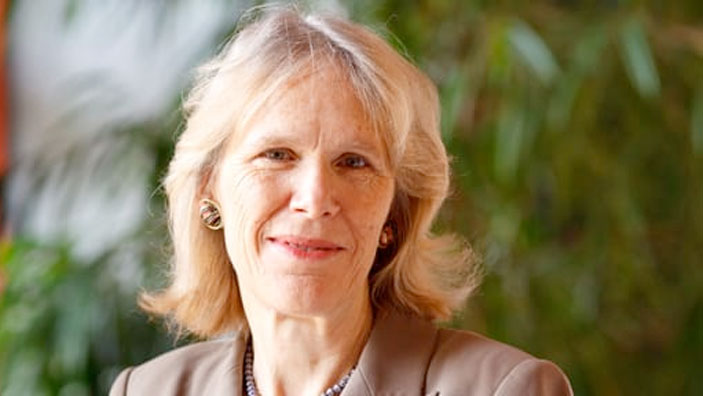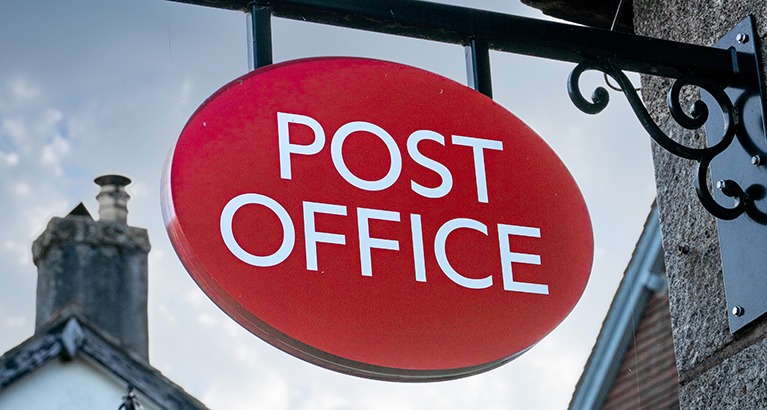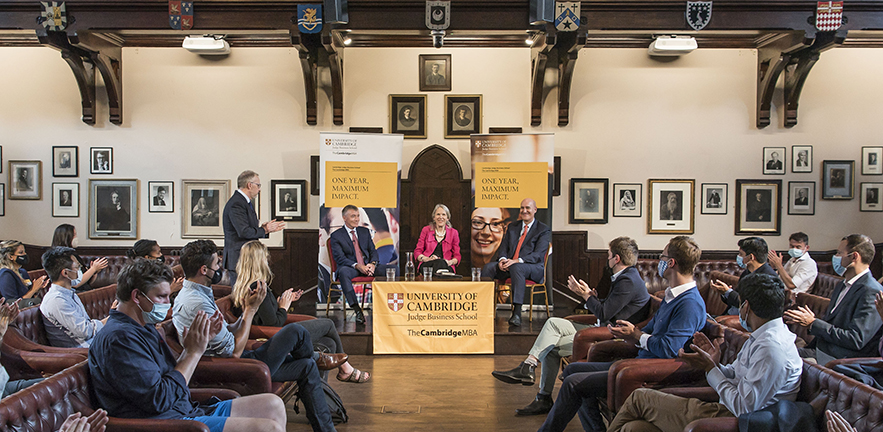KPMG Professor Emerita of Management Studies
Member of the Advisory Board, Cambridge Judge Business School
Fellow (Organisational Theory & Information Systems)
Fellow of Sidney Sussex College
BA (Keele University), MA (University of Cambridge), FIPH, FCGI, Hon DSc (Keele University), Hon DSc (University of London, Royal Holloway), CIM, DBE “in recognition of her contribution to higher education and management research”
I am a member of the Organisational Theory and Information Systems subject group.
My research interests are leadership, organisational change, technology transfer and knowledge sharing, health management and health policy.

Professional experience
Dame Sandra is KPMG Professor Emerita at Cambridge Judge Business School. She was Director of Cambridge Judge Business School from 1995 to 2006, Master of Sidney Sussex College from 1999 to 2009 and one of the Deputy Vice Chancellors of the University from 2008 to 2012. She writes and consults on organisational behaviour, leadership and innovation.
In 2004 Dame Sandra was invested as a Dame Commander of the British Empire as part of the UK national honours system in recognition of her contribution to higher education and management research and in 2006 she was inducted into the International Women’s Forum’s International Hall of Fame in recognition of her achievements in business education and leadership development including being an outstanding role model for women who aspire to lead in the commercial, educational and not-for-profit sectors.
Dame Sandra has wide experience in the commercial, public and charitable sectors, through research, consultancy, executive development and Board membership. Former positions include Chair of Riverside Mental Health NHS Trust and the executive committee of the Social Science Research Council in the USA; Vice Chair of Oxfam, a Non-Executive Director of TSB Bank, Barclays, JPMorgan Claverhouse Investment Trust and the Financial Services Authority, and a member of the Prime Minister’s Council on Science and Technology, the Windrush Lessons Learned Review, UK’s Senior Salaries Review Body, and an Advisory Board for the Aga Khan University on building a business School to meet the needs of emerging economies. She currently serves on the Board of the American University of Sharjah, Chairs the Advisory Board of the Cambridge Museum of Zoology and sits on the Advisory Board of Cambridge Judge Business School.
Previous appointments
Professor Dawson was KPMG Professor of Management Studies at Cambridge Judge Business School from 1995 to 2013, and Director of the School from 1995 to 2006. Prior to joining Cambridge Judge she was Professor of Organisational Behaviour (1990-1995) and Deputy Director of the Management School (1987-1994) at Imperial College, London University. Between 1999 and 2009 she was Master of Sidney Sussex College, and from 2008 to 2012, one of the University of Cambridge’s Deputy Vice-Chancellors.
Publications
- Journal articles
- Books, monographs, reports and case studies
- Book chapters
- Conference papers
- Working papers
Journal articles
- Oborn, E., Barrett, M. and Dawson, S. (2013) “Distributed leadership in policy formulation: a sociomaterial perspective.” Organization Studies, 34(2): 253-276 (DOI: 10.1177/0170840612473552)
- Dawson, S. and Ahlering, B. (2010) “Tomorrow’s regulator: regulating in the changing landscape for providing public goods.” Public Governance: Journal for Public Management, Autumn: 37-44
- Oborn, E. and Dawson, S. (2010) “Learning across communities of practice: an examination of multidisciplinary work.” British Journal of Management, 21(4): 843-858 (DOI: 10.1111/j.1467-8551.2009.00684.x)
- Oborn, E. and Dawson, S. (2010) “Knowledge and practice in multidisciplinary teams: struggle, accommodation and privilege.” Human Relations, 63(12): 1835-1858 (DOI: 10.1177/0018726710371237)
- Dawson, S. (2004) “Balancing self-interest and altruism: corporate governance alone is not enough.” Corporate Governance: An International Review, 12(2): 130-133
- Bessant, J., Birley, S., Cooper, C., Dawson, S. et al. (2003) “The state of the field in UK management research: reflections of the Research Assessment Exercise (RAE) Panel.” British Journal of Management, 14(1): 51-68
- Sutherland, K. and Dawson, S. (2002) “Making sense in practice: doctors at work.” International Studies of Management and Organization, 32(2): 51-69
- Dawson, S. and Dargie, C. (1999) “New public management: an assessment and evaluation with special reference to UK health.” Public Management, 1(4): 459-481
- Dawson, S., Sutherland, K., Dopson, S. and Miller, R. (1999) “Changing clinical practice: views about the management of adult asthma.” Quality in Health Care, 8(4): 253-261
- Dopson, S., Miller, R., Dawson, S. and Sutherland, K. (1999) “Influences on clinical practice: the case of glue ear.” Quality in Health Care, 8(2): 108-118
- Sutherland, K. and Dawson, S. (1998) “Power and quality improvement in the new NHS: the roles of doctors and managers.” Quality in Health Care, 7(Suppl.): S16-S23
- Moss, F., Garside, P. and Dawson, S. (1998) “Editorial: Organisational change: the key to quality improvement.” Quality in Health Care, 7(Suppl.): S1-S2
- Dawson, S. (1997) “Editorial: Inhabiting different worlds: how can research related to practice?” Quality in Health Care, 6(4): 177-178
- Mole, V., Dawson, S., Winstanley, D. and Sherval, J. (1997) “Transforming the National Health Service: the challenge for career management.” Journal of Management in Medicine, 11(3): 157-167
- da Fonseca e Silva, R. and Dawson, S. (1996) “Understanding strategic decision making in the context of international space activities.” Space Policy, 12: 29-43
- Mole, V., Dawson, S., Winstanley, D. and Sherval, J. (1996) “Transforming the National Health Service: the challenge for career management.” Journal of Managerial Psychology, 11(7): 40-50
- Dawson, S. (1995) “Never mind solutions, what are the issues? Lessons of industrial technology transfer for quality in health care.” Quality in Health Care, 4(3): 197-203
- Dawson, S., Mole, V., Winstanley, D. and Sherval. J. (1995) “Management, competition and professional practice: medicine and the market place.” British Journal of Management, 6(3): 169-181
- Shaw, R.J., Mitchell, D.M. and Dawson, S. (1995) “Motivation of consultant physicians.” British Journal of Health Care Management, 1: 648-652
- Winstanley, D., Sorabji, D. and Dawson, S. (1995) “When the pieces don’t fit: a stakeholder power matrix to analyse public sector restructuring.” Public Money and Management, 15(2): 19-26
- Dawson, S. (1994) “Changes in the distance: professionals reappraise the meaning of management.” Journal of General Management, 20(1): 1-21
- Dawson, S. and Steward, K. (1991) “Annual reports and 1992: cultural differences and the creation of a pan-European marketing tool.” European Business Journal, 3(4): 48-52
- Steward, K. and Dawson, S. (1991) “Pan-European annual reports – eventually.” Professional Investor, Sep: 54-58
- Dawson, S. (1987) “Industrial robot hazards and strategies for safety.” Industrial Safety Data File, Mar: D:16:1-6
- Dawson, S. (1986) “What is a safety officer and how should you train him?” Occupational Safety and Health, Dec: 14-17
- Jones, R. and Dawson, S. (1986) “Strategies for ensuring safety with industrial robot systems.” Omega: International Journal of Management Science, 14(4): 287-297
- Dawson, S., Clinton, A., Bamford M. and Willman, P. (1985) “Safety in construction: self regulation, industrial structure and workforce involvement.” Journal of General Management, 10(4): 21-38
- Dawson, S., Poynter, P. and Stevens, D. (1984) “Safety specialists in industry: roles, constraints and opportunities.” Journal of Occupational Behaviour, 5(2): 253-270
- Dawson, S., Pointer, P. and Stevens, D. (1984) “Resolving the health and safety conflict.” Management Today, Apr: 33-36
- Dawson, S., Poynter, P. and Stevens, D. (1983) “How to secure an effective health and safety programme at work.” Omega: The International Journal of Management Science, 11(5): 433-446
- Dawson, S., Poynter, P. and Stevens, D. (1982) “Activities and outcomes: monitoring safety performance.” Chemistry and Industry, 16 October: 790-796
- Dawson, S., Poynter, P. and Stevens, D. (1982) “Strategies for controlling hazards at work.” Journal of Safety Research, 13(3): 95-112
- Dawson, S. (1979) “Organisational analysis and the study of policy formulation and implementation.” Public Administrator Bulletin, 31: 52-68
Books, monographs, reports and case studies
- Dawson, S.J.N., Garside, P., Hudson, R. and Bicknell, C (2009) The design and establishment of the Leadership Council: a report for the CEO of the NHS. London: Department of Health.
- Dawson, S. and Morris, Z.S. (2009) Future public health: burdens, challenges and opportunities. London: Palgrave Macmillan.
- Dawson, S., Morris, Z.S., Erickson, W., Lister, G., Altringer, B., Garside, P. and Craig, M. (2007) Engaging with care: a vision for the health and care workforce of England. London: The Nuffield Trust.
- Morris, Z.S., Chang, L.R., Dawson, S. and Garside, P. (eds.) (2006) Policy futures for UK health. Oxford: Radcliffe Publishing.
- Dawson, S. and Sausman, C. (eds.) (2005) Future health organisations and systems. London: Palgrave Macmillan.
- Dargie, C. in association with Dawson, S. and Garside, P. (2000) Policy futures for UK health: 2000 report. London: Stationery Office.
- Dargie, C., in association with Dawson, S. and Garside, P. (1999) Policy futures for UK health: Pathfinder: a consultation document. London: Nuffield Trust.
- Dawson, S. (1996) Analysing organisations. London: Macmillan, 3rd edition.
- Dawson, S., Mole, V., Winstanley, D. and Sherval, J. (1995) Managing in the NHS: a study of senior executives. London: HMSO.
- Dawson, S., Willman, P., Clinton, A. and Bamford, M. (1988) Safety at work: the limits of self-regulation. Cambridge: Cambridge University Press.
Book chapters
- Dawson, S. (2010) “Joan Woodward: a style fit for the task.” In Phillips, N., Sewell, G. and Griffiths, D. (eds.): Technology and organization: essays in honour of Joan Woodward. Bingley: Emerald, pp.29-34 (DOI: 10.1108/S0733-558X(2010)0000029008)
- Dawson, S. (2005) “Introduction.” In Dawson, S. and Sausman, C. (eds.): Future health organisations and systems. London: Palgrave Macmillan, pp.1-14
- Dawson, S., Bhopal, R., Lister, G., Morris, Z.S., Wait, S. and Zimmern, R. (2005) “Where are the linkages for joined-up policy?” In Morris, Z.S., Chang, L.R., Dawson, S. and Garside, P. (eds.): Policy futures for UK health. Oxford: Radcliffe Press, pp.181-198
- Dawson, S. and Morris, Z.S. (2005) “Future policy challenges.” In Morris, Z.S., Chang, L.R., Dawson, S. and Garside, P. (eds.): Policy futures for UK health. Oxford: Radcliffe Press, pp.199-200
- Dawson, S. and Morris, Z.S. (2005) “Who’s going to govern?” In Morris, Z.S., Chang, L.R., Dawson, S. and Garside, P. (eds.): Policy futures for UK health. Oxford: Radcliffe Press, pp.65-86
- Dawson, S., Morris, Z.S. and Chang, L.R. (2005) “Introduction.” In Morris, Z.S., Chang, L.R., Dawson, S. and Garside, P. (eds.): Policy futures for UK health. Oxford: Radcliffe Press, pp.1-6
- Dawson, S., Morris, Z., Chang, L. and Sausman, C. (2005) “Conclusion.” In Dawson, S. and Sausman, C. (eds.): Future health organisations and systems. London: Palgrave Macmillan, pp.298-307
- Sausman, C., Dawson, S. with Chang, L. (2005) “The shape of UK health systems.” In Dawson, S. and Sausman, C. (eds.): Future health organisations and systems. London: Palgrave Macmillan, pp.17-41
- Dawson, S. and Dargie, C. (2002) “New public management: a discussion with special reference to UK health.” In McLaughlin, K., Osbourne, S.P. and Ferlie, E. (eds.): The new public management: current trends and future prospects. London: Routledge, pp.34-56
- Dargie, C. and Dawson, S. (2001) “Policy futures for UK health: examining the future health work force.” In Ashburner, L. (ed.): Organisational behaviour and organisation studies in health care: reflections on the future. Basingstoke: Palgrave, pp.43-63
- Dawson, S. (2000) “Celebration, commiseration and common sense.” In British Safety Council (eds.): What price your corporate reputation? London: British Safety Council, pp.3-4
- Dawson, S. (2000) “Untitled.” In Clifton, R. and Maughan, E. (eds.): Future of brands: twenty-five visions. Basingstoke: Macmillan, pp.74-77
- Dawson, S. (1998) “Woodward, Joan (1916-71).” In Warner, M. (ed.): The IEBM handbook of management thinking. London: International Thomson Business Press, pp.759-765
- Dawson, S. (1997) “Woodward, Joan (1916-71).” In Sorge, A. and Warner, M. (eds.): The IEBM handbook of organizational behaviour. London: International Thomson Business Press, pp.705-711
- Dawson, S. (1996) “Corporate responsibility and effective management.” In Hazards Forum (eds.): Safety by design: an engineer’s responsibility for safety.London: Hazards Forum, pp.128-148
- Dawson, S. (1996) “UK business schools.” In: Research and training directory UK, higher education expertise: business and management.London: Overseas Trade Services, pp.10-12
- Dawson, S. (1996) “Woodward, Joan (1916-71).” In Warner, M. (ed.): International encyclopedia of business and management.London: Routledge, 1st edition, pp.5069-5075
- Dawson, S., Sherval, J. and Mole, V. (1996) “In or out of management? Dilemmas and developments in public health medicine in England.” In Leopold, J., Glover, I. and Hughes, M. (eds.): Beyond reason? The National Health Service and the limits of management.London: Avebury, pp.157-172
- Dawson, S. (1995) “Technology transfer.” In Nicholson, N. (ed.): The Blackwell encyclopedic dictionary of organizational behavior.Cambridge, Mass.: Blackwell Business, pp.560-563
- Dawson, S. (1992) “Knowledge is not enough: developing the capacity for self-regulation in health and safety at work.” In Barrar, P. and Cooper, C.L. (eds.): Managing organisations in 1992: strategic responses.London: Routledge, pp.221-243
- Jones, R. and Dawson, S. (1985) “People and robots: their safety and reliability.” In Bonney, M. and Yong, Y. (eds.): Robot safety.Berlin: Springer-Verlag, pp.65-81
- Dawson, S. and Wedderburn, D. (1980) “Introduction: Joan Woodward and the development of organization theory.” In Woodward, J.: Industrial organization: theory and practice. Oxford: Oxford University Press, 2nd edition, pp.xiii-xxvi
- Dawson, S. (1975) “Power and influence in prison workshops.” In Abell, P. (ed.): Organizations as bargaining and influence systems.London: Heinemann, pp.151-186
- Davies, C., Dawson, S. and Francis, A. (1973) “Technology and other variables: some current approaches in organization theory.” In Warner, M. (ed.): The sociology of the workplace: an interdisciplinary approach.London: George Allen & Unwin, pp.149-163
Conference papers
- Dawson, S. (1997) “Improving performance and managing change: the report on the inaugural seminar in the Cambridge International Health Leadership Programme.” In Judge Institute of Management (ed.) Cambridge International Health Leadership Programme, 3-10 April 1997, Cambridge, England. Cambridge: Judge Institute of Management.
- Dawson, S. (1991) “Managing safety offshore.” In Bufton, R., Evripidou, A. and Williams, K. (eds.) Offshore operations post Piper Alpha: IMarE/RINA Joint Offshore Group International Conference, 6-8 February 1991, London, England. London: Institute of Marine Engineers, pp.13.1-13.11
- Jones, R. and Dawson, S. (1984) “People and robots: their safety and reliability.” In Brock, T.E. (ed.) British Robot Association Annual Conference (7th), 11-16 May 1984, Cambridge, England. Bedford: British Robot Association/North-Holland, pp.243-258
Working papers
- Dawson, S., Dopson, S., Sutherland, K., Miller, R. and Law, S. (1996) “Relating research to practice in the UK National Health Service.” Judge Institute of Management, Cambridge University, Research Paper No.1996/20
News and insights

The reports will address issues of management, culture and governance relating to the faulty IT system in the UK’s Post Office scandal.

A discussion panel at Cambridge Judge Business School explores how to overcome barriers to more successful EDI (equality, diversity, inclusion) strategies.

Insight
Three deans
Past, present and future Deans of Cambridge Judge Business School address business education and grand societal challenges at the Cambridge Union.

